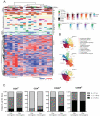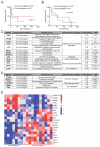Comprehensive Characterization of Human Lung Large Cell Carcinoma Identifies Transcriptomic Signatures with Potential Implications in Response to Immunotherapy
- PMID: 35329826
- PMCID: PMC8953709
- DOI: 10.3390/jcm11061500
Comprehensive Characterization of Human Lung Large Cell Carcinoma Identifies Transcriptomic Signatures with Potential Implications in Response to Immunotherapy
Abstract
Lung cancer is the leading cause of cancer mortality worldwide, with non-small cell lung cancer (NSCLC) being the most prevalent histology. While immunotherapy with checkpoint inhibitors has shown outstanding results in NSCLC, the precise identification of responders remains a major challenge. Most studies attempting to overcome this handicap have focused on adenocarcinomas or squamous cell carcinomas. Among NSCLC subtypes, the molecular and immune characteristics of lung large cell carcinoma (LCC), which represents 10% of NSCLC cases, are not well defined. We hypothesized that specific molecular aberrations may impact the immune microenvironment in LCC and, consequently, the response to immunotherapy. To that end, it is particularly relevant to thoroughly describe the molecular genotype-immunophenotype association in LCC-to identify robust predictive biomarkers and improve potential benefits from immunotherapy. We established a cohort of 18 early-stage, clinically annotated, LCC cases. Their molecular and immune features were comprehensively characterized by genomic and immune-targeted sequencing panels along with immunohistochemistry of immune cell populations. Unbiased clustering defined two novel subgroups of LCC. Pro-immunogenic tumors accumulated certain molecular alterations, showed higher immune infiltration and upregulated genes involved in potentiating immune responses when compared to pro-tumorigenic samples, which favored tumoral progression. This classification identified a set of biomarkers that could potentially predict response to immunotherapy. These results could improve patient selection and expand potential benefits from immunotherapy.
Keywords: checkpoint inhibitors; immunotherapy; lung large cell carcinoma; multiparametric analysis; non-small cell lung cancer; predictive biomarkers.
Conflict of interest statement
L.P.-A. has received honoraria for scientific advice and speaker fees from Lilly, Merck Sharp & Dohme, Bristol-Myers Squibb, Roche, PharmaMar, Merck, AstraZeneca, Novartis, Boehringer Ingelheim, Celgene, Servier, Sysmex, Amgen, Incyte, Pfizer, Ipsen, Adacap, Sanofi, Bayer and Blueprint, and participates as an external member of the board of Genómica. He is founder and board member of Altum sequencing and has received institutional support for contracted research from Merck Sharp & Dohme, Bristol-Myers Squibb, AstraZeneca and Pfizer. E.M.G.-M. has received honoraria for scientific advice from Bristol-Myers Squibb and speaker fees from Illumina Inc and Pfizer. She is currently an employee of PharmaMar. J.Z. has served as a consultant for AstraZeneca, Pfizer, BMS, Novartis, and Guardant Health, has received speaker’s honoraria from BMS, Pfizer, Roche, AstraZeneca, NanoString and Guardant Health, travel honoraria from BMS, Pfizer, Roche, AstraZeneca, and NanoString, and grant support/funds from BMS, AstraZeneca, and Roche. E.C. has received research grant support from Lilly, Roche and ThermoFisher, and has received speaker or consulting fees from AstraZeneca, BMS, Lilly, MSD, Pfizer, Roche and Takeda. The remaining authors declare no competing financial interests.
Figures





Similar articles
-
The Landscape of Actionable Molecular Alterations in Immunomarker-Defined Large-Cell Carcinoma of the Lung.J Thorac Oncol. 2019 Jul;14(7):1213-1222. doi: 10.1016/j.jtho.2019.03.021. Epub 2019 Apr 9. J Thorac Oncol. 2019. PMID: 30978501
-
Prognostic characterization of immune molecular subtypes in non-small cell lung cancer to immunotherapy.BMC Pulm Med. 2021 Nov 29;21(1):389. doi: 10.1186/s12890-021-01765-3. BMC Pulm Med. 2021. PMID: 34844602 Free PMC article.
-
Transcriptome-based molecular subtyping of non-small cell lung cancer may predict response to immune checkpoint inhibitors.J Thorac Cardiovasc Surg. 2020 Apr;159(4):1598-1610.e3. doi: 10.1016/j.jtcvs.2019.10.123. Epub 2019 Nov 11. J Thorac Cardiovasc Surg. 2020. PMID: 31879171
-
Large cell carcinoma of the lung: a tumor in search of an author. A clinically oriented critical reappraisal.Lung Cancer. 2015 Mar;87(3):226-31. doi: 10.1016/j.lungcan.2015.01.008. Epub 2015 Jan 17. Lung Cancer. 2015. PMID: 25620799 Review.
-
Immune checkpoint blockade as a potential therapeutic target in non-small cell lung cancer.Expert Opin Biol Ther. 2016 Oct;16(10):1209-23. doi: 10.1080/14712598.2016.1214265. Epub 2016 Aug 5. Expert Opin Biol Ther. 2016. PMID: 27426430 Review.
Cited by
-
Whole-exome and targeted gene sequencing of large-cell lung carcinoma reveals recurrent mutations in the PI3K pathway.Br J Cancer. 2023 Aug;129(2):366-373. doi: 10.1038/s41416-023-02301-2. Epub 2023 May 13. Br J Cancer. 2023. PMID: 37179440 Free PMC article.
-
The complex role and molecular mechanism of family with sequence similarity genes in cancer: a comprehensive review.Discov Oncol. 2025 Jul 30;16(1):1443. doi: 10.1007/s12672-025-03241-4. Discov Oncol. 2025. PMID: 40736938 Free PMC article. Review.
-
CIGB-300 Anticancer Peptide Differentially Interacts with CK2 Subunits and Regulates Specific Signaling Mediators in a Highly Sensitive Large Cell Lung Carcinoma Cell Model.Biomedicines. 2022 Dec 25;11(1):43. doi: 10.3390/biomedicines11010043. Biomedicines. 2022. PMID: 36672551 Free PMC article.
-
Interleukin-11 promotes lung adenocarcinoma tumourigenesis and immune evasion.Clin Transl Med. 2025 Jul;15(7):e70374. doi: 10.1002/ctm2.70374. Clin Transl Med. 2025. PMID: 40673604 Free PMC article.
-
LncRNA RP11-297P16.4 Promotes the Invasion and Metastasis of Non-Small-Cell Lung Carcinoma by Targeting the miR-145-5p/MMP-2/9 Axis.Biomedicines. 2025 Mar 3;13(3):617. doi: 10.3390/biomedicines13030617. Biomedicines. 2025. PMID: 40149594 Free PMC article.
References
-
- Travis W.D., Brambilla E., Nicholson A.G., Yatabe Y., Austin J.H.M., Beasley M.B., Chirieac L.R., Dacic S., Duhig E., Flieder D.B., et al. The 2015 World Health Organization Classification of Lung Tumors: Impact of Genetic, Clinical and Radiologic Advances Since the 2004 Classification. J. Thorac. Oncol. 2015;10:1243–1260. doi: 10.1097/JTO.0000000000000630. - DOI - PubMed
Grants and funding
- BMS#OT123-315/Bristol Myers Squibb
- PI17/00778/Fondos FEDER
- PI20/00870/Fondos FEDER
- AC20/0070/Fondos FEDER
- B2017/BMD-3884/iLUNGProgram Comunidad de Madrid
- CB16/12/00442/Spanish Network of Biomedical Research in Cancer (CIBERONC)
- TRNSC18004PAZ/AECC
- Unidad Integral CRIS de Inmuno-oncología/Fundación CRIS contra el cáncer
- Marie Skłodowska-Curie Post-doctoral Research Fellowship under Grant Agreement #713406 (to EMGM)/European Respiratory Society/Horizon2020 COFUND
- FPU predoctoral fellowship #FPU16/00382 (to JRP)/Spanish Ministry of Education
LinkOut - more resources
Full Text Sources

